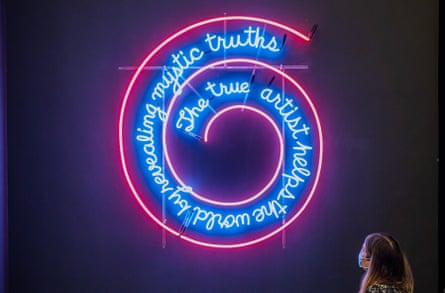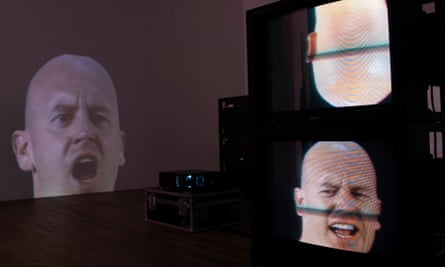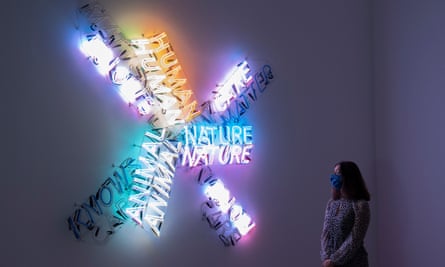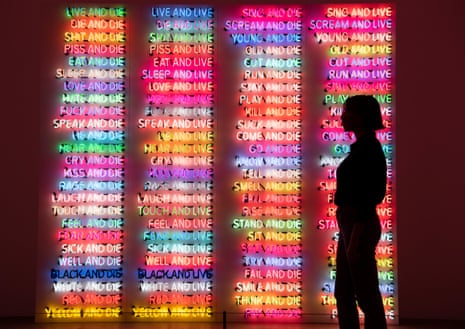Even before you get to Bruce Nauman’s exhibition at Tate Modern, he’s there. Washing his hands in a two-monitor video installed on the ground floor that inverts the same ritual, the same suds, the same palms and fingers kneading water and soap. Nauman’s voices follow you up and down the stairwell, in a replay of his 2004 Turbine Hall commission, Raw Materials. In the Tate cafe, the video Good Boy, Bad Boy plays on monitors, like a disturbing conversation at the next table, while an hour-long video shows Nauman on his ranch, prosaically setting fences in the sun and heat. At the entrance to his show is a bright neon work, the one that tells you that the true artist helps the world by revealing mystic truths. Fat chance, as the artist might say.
And then we are there, plunged into the New Mexico night, and the mess of Nauman’s studio, where he installed cameras to record the nocturnal activity in the empty building. Insects doodle bright trails of light in the gloom. There goes a mouse, running along the foot of a wall. I know that a cat appears at some point, but I missed it, in this almost six-hour work filmed over several weeks in 2001. I sit in one of the swivel chairs dotted about the dark space, paddling in circles with my feet and taking in the seven projected views, which are sometimes flipped back to front or inverted, bleached-out or saturated in colour. Sitting there turning in the projected night I feel like I have become part of the installation, and that I’m method-acting the artist himself, marooned in that creative emptiness from which everything in his art flows.

All sorts of rubbish and clutter lies around. There’s a bucket, filthy with dried plaster. And a couple of waxy casts of human heads, dumped in the shadows on the floor. The word PROJECT is written on the wall – apropos of who knows what. Nothing gets a closeup and the cameras don’t dwell on any of the details. The studio is the place where everything gets started, grinds to a halt, takes a reverse direction, begins again. The studio is the epicentre of Nauman’s art, the place where he paces about, tries things out, drinks coffee, works at his inertia. Mapping the Studio is as much about dead time and waiting as it is a record of a place when he’s not there.
Throughout his long career Nauman has made works from the near-to-hand (even from his hands themselves), from the circumstances he finds himself in, from floors and walls and his own body. In one of several early videos from the 1960s, we see him bouncing off the wall. In another he does a mincing contrapposto walk back and forth in a narrow corridor. In another, he gets himself into tortuous positions he can’t hold for long, and walks in “an exaggerated manner” around the perimeter of a square he has marked out with tape on the studio floor. The things people get up to when they’re alone.
Early sculptures saw him casting the space under his chair and, in Henry Moore Bound to Fail, casting his own back, with his hands tied behind him with rope (the thinking here was that however much younger British artists rejected Moore’s influence in the 1960s, they might need him later). As it is, nothing gets lost in Nauman’s art, and he returns to the same themes time and again - physical and psychological duress, cruelty and humour – the two are ever entwined, whether it is the slapstick of a man slipping on a banana skin, an abject clown in the toilet or a hanged man getting a startling involuntary erection in Nauman’s bawdy, awful neon version of the game Hangman.
He even gets the viewer caught up in his roundelays of reversals and repetitions, inviting us to get sandwiched in a wire-mesh corridor through which we can barely pass (though you can’t at Tate, for obvious Covid health and safety concerns), or to walk around a long, free-standing wall, where a camera records our passing and presents it on a monitor around the next corner, so we end up chasing our own time-delayed image, which disappears as soon as we catch sight of it. Constantly failing to catch up with yourself, you could spend all day going not so much round the wall as round the bend.

As well as the detritus of the studio there is a lot of sonic clutter in the galleries, and the cumulative sound leakage drives you on and keeps you on edge: the noise of camera equipment and projectors, amplified footfalls, distant yelling, the shouting clowns, the hum and clack of his neon works, the multiple ascendant bellowing and keening of actor and singer Rinde Eckert in Anthro/Socio from 1992. Cacophonous and unnerving, I have encountered Anthro/Socio, with the bald Eckert spinning multiple times, left to right and right to left, inverted and the right way up as he urgently roars out Nauman’s brief implorings, on many occasions since first seeing it at the Hayward in 1998. What strikes me now is Eckert’s extreme, staged vulnerability, his unappeasable unending infant need and isolation. “Feed me, help me, eat me, hurt me,” he cries, in a rising stentorian clamour that never ceases. As a kind of counterpoint, or perhaps a premonition, one early sculpture has a mute concrete block with a plug and electrical cord emerging from it, like a cartoonish tail. Buried inside the block is a reel-to-reel tape recorder. Its original title was Tape Recorder with a Tape Loop of a Scream Wrapped in a Plastic Bag and Cast into the Center.

Later, we see a female mime artist following the instructions of an unseen male, who dispassionately orders her to adopt different poses, including playing dead. Those waxy human heads return in a kind of shadow puppetry in the corners of the room where she appears and disappears, projected on the walls and on monitors. Sometimes we see a disembodied head swinging like a pendulum. The mawkish mime’s costume and makeup make her seem less a performer than victim in a theatre of cruelty. Maybe her role protects her from it all becoming far too real.
However well I think I know Nauman’s art, and most of the works here, this pared-down survey of over 50 years of work continues to thrill and to disturb. I have no doubt at all of Nauman’s greatness, from his early, clunky black-and-white videos in which he is like a man trying to keep fit and to assert some agency in solitary, to a later sculptural installation, in which black marble cubes sit in the nasty pallor of yellow sodium lights, and in which minimalism is turned into a kind of authoritarian terminus. In the work Walks In, Walks Out, a visibly aged Nauman walks in front of his own 2015 reworking of his 1968 video Walk with Contrapposto: here, Nauman reminds me of one of Alfred Hitchcock’s turns as a walk-on part in his own movies. Nauman the artist, like Hitchcock, is not above self-parody and humour, as well as being thoroughly uncompromising. Squeezing the most out of almost nothing at all he takes everything to the limit. And then some.
Bruce Nauman is at Tate Modern, London, from 7 October to 21 February.
